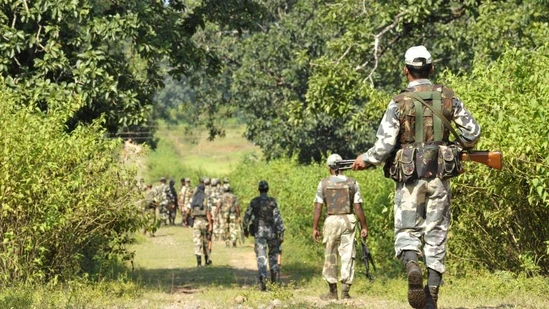Security forces have captured the strategic Karreguttalu hills along the Chhattisgarh-Telangana border, once under the exclusive control of Maoists, killing 31 rebels during a mammoth three-week operation involving 26,000 personnel, officials announced on Wednesday.
The operation, titled Black Forest and concluded on May 11, dismantled what authorities described as the unified headquarters of several Naxal formations, including the notorious People’s Liberation Guerrilla Army (PLGA) Battalion 1, the DKSZC, TSC, and the CRC.
“The hills which were ruled by red terror now proudly hoist the tricolour,” said Union home minister Amit Shah, calling it the “biggest operation till date.”
Prime Minister Narendra Modi, quoting Shah’s post on X, added: “This success of the security forces shows that our campaign towards rooting out Naxalism is moving in the right direction. We are fully committed to establishing peace in the Naxal-affected areas and connecting them with the mainstream of development.”
The scale of the operations was such that the forces – personnel from the central and state – built a helipad on top of the hills during their campaign.
CRPF director general GP Singh told reporters in Bijapur: “This was the main den of the Naxals. Around 300-350 had settled and were operating from here. It was a no-go area for security forces all these years.”
The joint operation, supported by the Indian Air Force (IAF), revealed an extensive network of approximately 250 caves converted into weapons manufacturing facilities. Four technical teams from Battalion 1 were manufacturing weapons for the armed insurgency army from this camp. Forces uncovered factories producing guns, grenades, and under-barrel grenade launchers, complete with generators powering the production facilities, junior personnel involved in the operation said, asking not to be named.
“Cave intervention is a new learning from this operation. Generally, our troops are trained for house intervention, vehicle intervention and things like that,” Singh said, explaining that the troops faced unfamiliar tactical challenges in the cave environment. He added that the success “is the beginning of the end for Naxal groups.”
Security personnel also discovered nearly 450 improvised explosive devices (IEDs) planted throughout the hills. Fifteen undetected devices detonated during the operation, injuring 18 personnel. No security force fatalities were reported.
Officers noted that the Naxals had established their own markers to identify IED locations, allowing them to navigate safely through the mined area.
Among the materials seized were 12,000 kg of food rations, printers used for producing propaganda, and 818 barrel grenade launcher shells manufactured in the cave factories.
Chhattisgarh police chief Arun Dev Gautam said intelligence reports several months ago indicated Naxals from different states were establishing a unified command at the location. “The hills are almost 50 km long and have a width of around 5 to 20 km at different places. In the last year, they had set up a base where 350 armed cadres had taken shelter,” Gautam said.
Across the cave network, forces found four Maoist technical units for arms manufacturing, along with medicine and first aid kits, sewing machines for stitching Naxal uniforms, and 1,100 beer bottles.
CRPF DG Singh revealed they had discovered “a new phenomenon of Naxals using beer bottles to pack minimal explosives, which are hard to detect but effective to cause injuries.”
The 28 Naxals identified thus far carried combined rewards of ₹1.72 crore announced by various state police forces. Officials are still verifying reports of senior Maoist members killed or wounded in the operation.
When questioned about top Maoist commander Hidma, who was believed to be hiding in the area, CRPF chief Singh said: “Whatever we had set out to do, we have achieved more than that. It was to dislocate and break the leadership that had congregated at one place.” He acknowledged the difficulties in retrieving bodies in the challenging terrain: “Retrieving bodies is also difficult in that terrain.”
Infamously known as the “black hills,” the 60-km stretch features elevations of 700-900 metres with absolutely no road access, making it an ideal hideout for the banned group’s operations.
Much before it became the site of their unified command base, sometime in November or December last year, the Kerraguttalu hills were used as an escape route by the insurgents to flee into Telangana whenever forces intensified anti-Naxal operations in Chhattisgarh. This escape route has now been cut off by security forces.
During the 21-day operation, security forces engaged in 21 separate gunfights with Naxals, the officials said. Describing the remote and dense nature of the forest, one official added that they even encountered a bear during their mission.
On May 7, while the operation was still underway, Chhattisgarh chief minister Vishnu Deo Sai had posted on social media platform X about 22 Naxals killed in the operation, but later deleted the statement. An officer involved explained: “On May 7, the operation was still on. It was decided not to release any details about the operation until it was complete.”
The government has set a deadline of March 31, 2026, to eliminate Naxal violence completely. Singh emphasised the government’s “relentless and ruthless approach to ensure that the country is free of Naxals” by this date. Security forces have intensified their campaign, killing 197 Naxals this year, compared to 280 last year.
The aggressive operations have prompted retaliatory violence, with Naxals killing 16 civilians on suspicion of being police informers. Twenty security personnel have also been killed in the first five months of 2025.
Forces continue to sanitise the captured hills for remaining IEDs, which officials believe could number in the hundreds.
